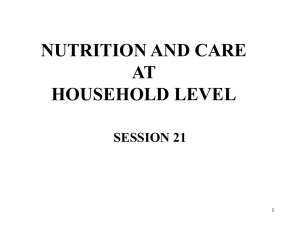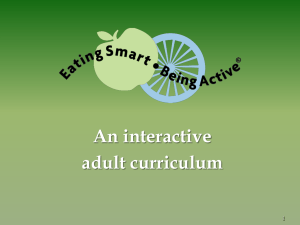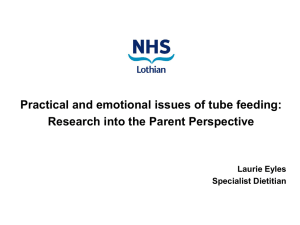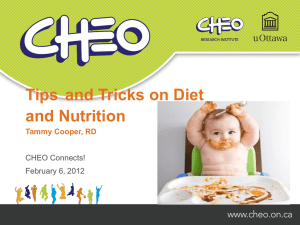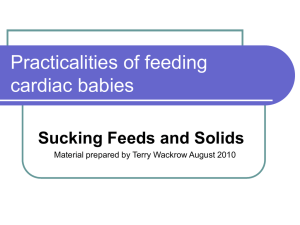The Feeding of Toddlers - Collaboration for Early Childhood
advertisement
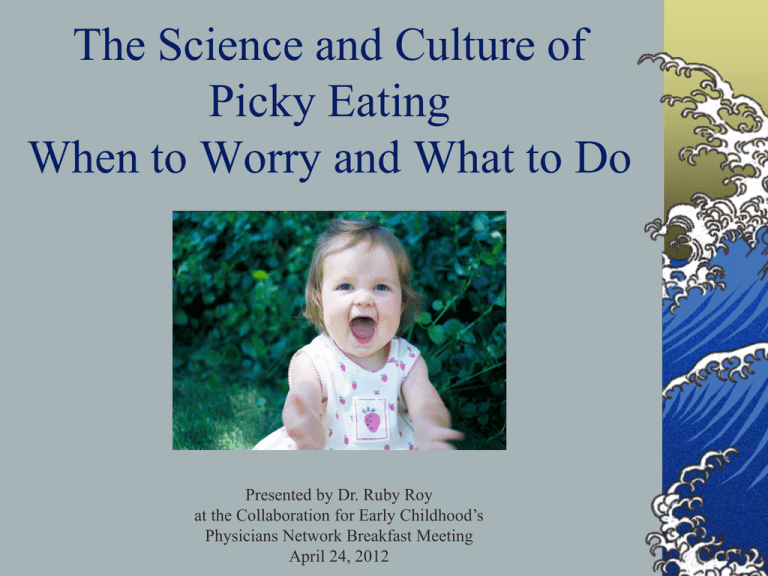
The Science and Culture of Picky Eating When to Worry and What to Do Presented by Dr. Ruby Roy at the Collaboration for Early Childhood’s Physicians Network Breakfast Meeting April 24, 2012 GOALS: Review normal growth and feeding patterns in toddlers Review the developmental and psychological stages of toddler hood (related to feeding) Understand the prevalence of feeding concerns and develop a culturally conscious approach Know when to refer and to whom Parent Concerns 1/3 of children are described as having feeding difficulties at some point prior to age 5 years. Parents rank feeding issues as #2 behavioral problem (crying is #1) frequently left unaddressed by their pediatrician. Picky Eating Being picky as a child (“neophobia”) is normal and adaptive with wide temperamental variation (“eats everything” to “only likes three foods”). From an evolutionary perspective, for simple survival children should be skeptical about eating any new food. Picky Eating On average, a food is offered 10 times before a child will accept it. Children have a more acute sense of taste than adults and should not always be expected to eat what their parents or caregivers are eating. Developmental Issues Normal drop off in growth in the second year of life Normal increase in exploration and development (motor and speech) More sensitive taste buds Development of independence The Growth Chart Growth percentiles are genetically determined Growth along (or parallel to) a curve is more important than actual weight—it is the RATE of weight gain that is important Differential growth for premature babies and for children with genetic syndromes Understanding the Growth Chart Growth charts normalized over a wide variety of ethnicities, and over both breast and formula babies Rapid growth first year, drop off in the second year of life Patterns with weight/height and head circumference are important in determining if growth is normal Growth 5% of children are underweight and up to 15% of children less than 5 years old are obese. Obesity has changed our perception of toddler size and has interfered with normalizing “slimming down” between 2-5 Breastfeeding Successful breastfeeding requires an attention to infant cues (not a schedule) Cannot control when or how much the infant eats Successful breastfed babies automatically self regulate intake and have fewer issues with obesity and food pickiness Development: Skills of Solid Feeding Bear weight on forearms in prone Good head control at 90 degrees in prone Loss of tongue thrust Keep tongue flat for spoon Close lips over spoon, scrape food off Keep food in mouth Social Milestones for Eating Mouthing fingers and objects Interested in other’s eating Wants to eat Opens mouth for spoon Stays open for food Turns head away when full Developmental First Feeding Usually between 5-7 mo Solid feeding not essential for nutrition at this age A “window of readiness” for solid textures May be delayed in preemies Developmental Food Continuum Smooth Purees Hard Munchables Meltable Hard Solids Soft Cubes Soft Mechanical Mixed Textures = Cube (6 months) (8 months) (9 months) (10 months) (11 months) ( 12 months) Importance of Self Feeding (8-14 months) Self feeding encourages self regulation of caloric intake Congruent with psychological development at same ages finding a balance between exploration and attachment Sense of self emerges along with recognition that “I can refuse this” as a way of expressing my self. Transitional Stage of Eating (8-14mo) Weaning formula or breast milk RELATIVE to growth and requirements Liquid intake should stay stable after 8 mo Decreasing calories from liquids vs solids By 9 mo, 30% of calories from solids By 12 mo, 50% of calories from solids Transitional stage of eating Managing this transition appropriately without overfeeding liquids (milk or juice) and appropriately increasing the right kinds of solid foods is the most challenging feeding milestone of the first year—esp. for bottle feeders Allowing self feeding is time-consuming, messy, and inefficient in the first year!! Motor Milestones Needed for Self Feeding 10 to 12 months Independent sitting in a variety of positions Pincer grasp developing Pokes food with index finger (sensory exploration) Uses fingers to selffeed soft and chopped foods Psychological Stages 8 to 14 months CHILD’S TASK = learn to explore their world and manage separation anxiety at the same time. The child controls HOW MUCH and WHETHER to eat. PARENT’S TASK = encourage new initiative in self feeding and allow exploration of foods WHILE providing structure, routines and safe boundaries. The parent controls WHAT and WHERE to eat What 1-Year-Olds Should Eat number of serving and serving size Grains, Beans, Legumes 4 to 6 servings a day ½ slice of bread,¼ bagel 1 ounce of cereal ¼ cup of cooked rice, pasta, peas Fruits and Vegetables 4 to 6 servings ¼ cup of vegetable ½ whole fruit or ½ cup chopped or cooked fruit Dairy Products 4 servings ½ cup whole milk ½ up yogurt 1 oz. cheese Protein: Meat, Fish, Poultry, Eggs, Tofu 2 to 4 servings a day 1 egg 2 oz. meat, fish poultry 2 ½ oz tofu Motor Milestones Needed for Feeding 14 to 16 months of age Efficient finger feeding Practicing utensil use 18 to 24 months of age Able to pick up, dip and bring foods to mouth Increased utensil use (usually not efficient until 24 months) Scoops purees with spoon and brings to mouth Psychological Stages 18 to 30 months CHILD’S TASK = to undertake body management more independently. May express dislike for foods Assertion of self by doing things differently and by self PARENT’S TASK = maintaining a positive relationship and teaching the concrete components of learning to eat and social interaction at meal time VERSUS on how much food gets into the child. Culture and Feeding Think about the meal time rules in your own house growing up. When you are a parent, will you teach your kids the same rules? Why or why not? Consider your own beliefs about how children should eat and how mealtime behavior may differ from those of your patients. Which beliefs are “cultural” and which are based in medical science? Culture is Everything Parents seek a wide variety of resources for advice for feeding help Advice given is from “common sense” Common sense comes from your own culture Definition of culture A person SELF DEFINES their culture (done in medical studies also) What they think of as their culture may be primarily determined by their family, their level of education/SES, or their life circumstances Make no assumptions: ASK Common Problems Rigid feeding schedules No schedule or structure to the day “Over healthy” low fat/vegan/goat’s milk Starting solids before infant is ready Not allowing self feeding Expectations of certain portion sizes Desire for certain body habitus What 2 to 6 Year-Olds Should Eat number of serving and serving size Grains, Beans, Legumes 6 servings a day 1 slice of bread,¼ bagel ½ cup of cooked cereal 1/2 cup of cooked rice, pasta, peas Fruits and Vegetables 4 to 6 servings 1 cup of vegetable 1 whole fruit or ½ cup chopped or cooked fruit Dairy Products 2 servings 1 cup whole milk 1 cup yogurt 2 oz. cheese Protein: Meat, Fish, Poultry, Eggs, Tofu 2 servings a day 2-3 oz. meat, fish poultry ½ cup of cooked dry beans 1 egg = 1 oz of meat 2 tablespoons peanut butter = 1 oz meat Case 1 Mina is a 20 month old, at the second percentile for weight and height, but at the 25 percentile for head circ. She is developmentally normal. Parents have been told by her PMD that she needs to gain better. Pediasure was prescribed. Monthly follow up. Case 1 Grandparents that she needs to eat more and that mother needed to be forced to eat Mealtimes are not family meals Maria eats alone because father restrains her and mother and grandmother force food in her mouth She is starting to throw up after these meals. Issues Is growth abnormal? Anxiety caused by pediatrician Family hx of force feeding Resultant vomiting Culture and Feeding Wonder what role culture plays when feeding is describe by the family as a problem? Remember that you have bias,too. Start by asking the family to explain the problem as they understand it. Listen to how the mother describes the child’s behavior Ask what other important family members think such as the father and grandmother think about feeding and the child’s behavior Case 3 Lupe is a 2 year old referred by physician to FTT clinic for evaluation of “eating disorder with no appetite”. She does not eat meat. She eats a good breakfast and lunch, but snacks through the afternoon and has a piece of bread and milk for dinner . Lupe is 95% for weight and 50% for height. Issues Pediatrician perception of feeding Is the growth really a problem Anxiety around both nutrition and health of child that generalizes Case 2 Eddie is a 2 year old with diagnosed ASD. He only eats peanut butter sandwiches and chicken nuggets. Mother was told by a occupational therapist that “This is behavioral, tell him that all the peanut butter and chicken nuggets are gone and he will have to try new foods.” Autism Spectrum Disorder Increased incidence of food selectivity Case reports of malnourished/FTT children with ASD Clinical experience with large families and children in poverty show that this experience is not universal Oral Motor Issues Difficulty with mixed textured foods, preferring only crunchy or soft Oral motor weaknesses with chewing, sucking, tongue movements Choking/gagging with trying nonpreferred textures Autism spectrum disorder Oral motor issues (textures of foods) Sensory issues (45-56% have issues with smell and taste of food) Rigidity and ritual—need for “sameness” Family stresses may not allow feeding issues to be addressed Anticipatory Guidance Anticipatory guidance and well child visits should always include information about the next potential feeding issues. During well child visits, use caution in interpreting the growth charts for families. Bigger is not always better. - Expressing excessive enthusiasm about an infant’s high rate of weight gain or weight at the 90th percentile on the curve can send the wrong message. - Parents should be praised for their excellent feeding style, not for the infant being at the 90th percentile on the curve. Allergy Concerns If the child refuses entire nutrient groups, consider a food sensitivity or food allergy. For example, dairy or gluten Usually accompanied by physical manifestation constipation diarrhea rash: hives or eczema Premature Babies Increased incidence of oral motor issues Oral aversion GERD Feeding milestones adjusted for developmental age Data on premature babies having and increased incidence of obesity When To Worry When the child is underweight/not following growth curve Concerns about micronutrient deficiency (Fe, Ca, vitamin D) Pattern of pickiness suggests an oralmotor problem or food sensitivity When extreme or prolonged What to Do History Diet Development Social Typical day Mealtime patterns Culture Ask and Wonder About: The structure of mealtimes Maternal feeding beliefs Frequency of feedings The parents expectations about the type and amounts of food Nutritional value of foods for different age groups Wonder about: Prestige and status of food types Healing and medical values of food Religious significance of foods Caregiver-child control of eating The Primary Pediatrician It may be that through your own relationship and rapport with family that you can help them change eating patterns Discussing normal development, growth, eating and social function Remember that with toddlers, growth may plateau while eating patterns are changing Supplements can help here Ellyn Satter’s DOR Division of Responsibility in Eating Parent is responsible for WHAT, WHEN and WHERE Child is responsible for WHETHER and HOW MUCH Anticipatory Guidance Structured mealtimes Family meals—social aspect (no TV/phones) No pressure to finish the plate No good food/bad foods Always have something the child will eat on the plate Evaluation Registered dietician evaluation Speech therapy evaluation Can be done via Early Intervention if <3 yrs Need to specify speech therapy for feeding evaluation Psychology/social work—family therapy Medical Workup Swallow evaluation: Oro-pharyngeal motility GERD evaluation Nutritional labs: CBC, iron studies, prealbumin, vitamin D, lead Feeding Therapy Address oral motor issues Gradual and systematic sensory desensitization of foods Visual Smell Touch Lips, teeth, tongue, bite Feeding Clinics Multidisciplinary clinics Dupage Easter Seals Central Dupage Hospital (CMH) Lutheran General La Rabida May have different focus/specialty Preemies, cerebral palsy, ASD In Summary Infant and toddler feeding and growth concerns are common in all cultures Culture provides different interpretations: range of family responses “Feeding concerns” are related to normal growth and developmental patterns and are best addressed by the primary pediatrician
